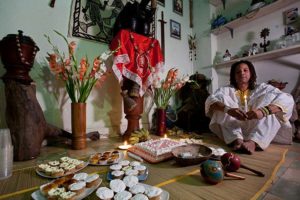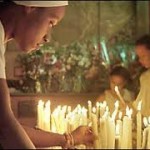 LA SANTERIA, RELIGION AFRO-CUBANA SE EXTIENDE ALREDEDOR DEL MUNDO.
LA SANTERIA, RELIGION AFRO-CUBANA SE EXTIENDE ALREDEDOR DEL MUNDO.
SANTERIA es una religión afro-caribeña, que es cada vez más una práctica generalizada en América del Norte con la inmigración continúa de América Latina y Cuba en particular. Los rituales de esta religión son extrañas, por los estándares occidentales convencionales ya menudo resultan en los informes de actividad delictiva o los llevan a la policía a suponer que un acto criminal se haya cometido. Los agentes de policía que investigan supuestas acciones criminales por parte de los practicantes de estas religiones deben estar familiarizados con el significado y la relevancia potencial de los artefactos y las prácticas religiosas de culto.
La santería es una religión popular entre los hispanos en general y cubano-americanos en particular. Al igual que otros afrocaribeños cultos practicados en Miami, como el vudú haitiano, Obeah y el candomblé brasileño, que se mezcla la religión africana con algunos aspectos del cristianismo. Los esclavos africanos español, francés y portugués introdujo al cristianismo y, en parte como un compromiso para asegurar la supervivencia cultural, los esclavos representaban las deidades africanas con los facsímiles de varios santos católicos (un fenómeno conocido como sincretismo). Los dioses y diosas de la santería son de origen africano occidental, específicamente de la cultura yoruba en el suroeste de Nigeria.
Para los practicantes de la santería, la mitología religiosa juega un papel importante en la adición de la lógica y la profundidad a la naturaleza simbólica de sus prácticas.
La comprensión de los mitos y leyendas de cada dios o diosa es fundamental para determinar lo que los animales o los alimentos se ofrecen, qué colores están asociados con las deidades, lo que las ceremonias se llevan a cabo en determinados días de la semana, las danzas específicas realizadas, y un anfitrión de otros los detalles pertinentes a la religión. Es importante señalar que estos mitos y leyendas son reales y significativos para los miembros de esta religión.
La siguiente es una descripción de los Orishas más populares:
También conocido como Echu, es el guardián de las encrucijadas. Todos los rituales están primero iniciado por la invocación de Eleguá. Él es conocido por castigar a aquellos que no lo respetan. Él es un dios inquieto, y para su propia diversión hace que mucha molestia a los mortales. Parece que incluso entre los otros dioses, que es un poco bromista, aunque a veces no es muy divertido. Los colores de Elegguá son el rojo y negro. Sus números son 3 y 21.
The beliefs and rituals of Santeria 
Se le considera el creador del mundo. El padre de todos los Santos y el Dios de paz. Su color es blanco y los números son 8 y 16.
Reina de los mares y la diosa de la maternidad. Se la representa como una madre virtuosa, prudente, inteligente y, al mismo tiempo cálida, humana y feliz. Sus colores son azul y blanco y el número es el 7.
Diosa del amor y la lujuria. Ella se describe como un ser sensual, ingenioso y malvado. Ella es también la diosa de los ríos, lagunas y el oro. Oshun representa todas las cosas dulces, hermosa y voluptuosa. Sus colores son el amarillo y el oro y el número es 5.
CHANGO
Dios de la virilidad y la fuerza, también de truenos y relámpagos. Por encima de todo lo que es representativo de la sexualidad desenfrenada. No hay ninguna deidad más vehemente ni energía. Su color es el rojo y el blanco y los números son 4 y 6.
El dios de todas las cosas hechas de hierro y minerales. Un dios guerrero. Está simbolizado por los machetes, picos, palas, martillos, y cualquier objeto de acero o de hierro. Sus colores son el verde y el negro y el número es el 7.
Dios de las enfermedades y vidente que puede mirar hacia el futuro. Sus colores son el morado y marrón o púrpura y amarillo y el número es 17.
Él es el dios de los cazadores y los lanzadores de conjuros. También es conocido como un dios de la justicia. Él se asocia frecuentemente con la policía, las cárceles, y el sistema legal. Su color marrón y beige y el número es 3.
Cabe mencionar que muchos seguidores de esta religión mantener estricto secreto respecto de su participación religiosa. Un buen índice de la popularidad de la santería es el número de tiendas de Botanica se encuentran en todo el condado de Dade, Florida. En la actualidad, existen alrededor de 60 botánicas que atienden a las necesidades de los seguidores de la santería en el área metropolitana de Miami.
 SANTERIA, AFRO-CUBAN RELIGION EXTENDS AROUND THE WORLD.
SANTERIA, AFRO-CUBAN RELIGION EXTENDS AROUND THE WORLD.
SANTERIA is an Afro-Caribbean religion, which is increasingly widespread practice in North America with continued immigration from Latin America and Cuba in particular. The rituals of this religion are strange, by conventional Western standards and often result in reports of criminal activity or lead them to the police to assume that a criminal act has been committed. Police officers investigating alleged criminal actions by practitioners of these religions should be familiar with the meaning and potential relevance of religious artifacts and religious practices.
Santeria is a popular religion among Hispanics in general and Cuban-Americans in particular. Like other Afro-Caribbean cults practiced in Miami, such as Haitian Voodoo, Obeah and Brazilian Candomblé, which mixes the African religion with some aspects of Christianity. The Spanish, French and Portuguese African slaves introduced Christianity and, in part as a commitment to ensure cultural survival, the slaves represented the African deities with the facsimiles of several Catholic saints (a phenomenon known as syncretism). The gods and goddesses of Santeria are of West African origin, specifically of the Yoruba culture in southwest Nigeria.
For santeria practitioners, religious mythology plays an important role in adding logic and depth to the symbolic nature of their practices.
Understanding the myths and legends of each god or goddess is essential in determining what animals or foods are offered, what colors are associated with the deities, what ceremonies are conducted on particular days of the week, the specific dances performed, and a host of other details pertinent to the religion. It is important to point out that these myths and legends are real and meaningful to the members of this religion.
The following is a description of the most popular Orishas:
ELEGGUA
Also known as Echu, is the guardian of the crossroads. All rituals are first begun by invoking Eleggua. He is known to punish those who do not respect him. He is a restless god, and for his own amusement causes much annoyance to mortals. It seems that even among the other deities, he is a bit of a practical joker, though at times not very funny. The colors of Eleggua are red and black. His numbers are 3 and 21.
OBATALA
He is considered the creator of the world. The father of all the Orishas and the god of peace. His color is white and the numbers are 8 and 16.
YEMAYA
Queen of the seas and goddess of motherhood. She is depicted as a virtuous mother, prudent, intelligent, and at the same time warm, human and happy. Her colors are blue and white and the number is 7.
Goddess of love and lust. She is depicted as being sensuous, witty and wicked. She is also the goddess of rivers, lagoons and gold. Oshun represents all things sweet, beautiful and voluptuous. Her colors are yellow and gold and the number is 5.
CHANGO
God of virility and strength, also of thunder and lightning. Above all he is representative of unbridled sexuality. There is no deity more vehement nor energetic. His color is red and white and the numbers are 4 and 6.
OGGUN
The god of all things made of iron and mineral. A warlike god. He is symbolized by machetes, picks, shovels, hammers, and any object made of steel or iron. His colors are green and black and the number is 7.
BABALU AYE>
God of illnesses and seers who can look into the future. His colors are purple and brown or purple and yellow and the number is 17.
OCHOSI
He is the god of hunters and spells casters. He is also known as a god of justice. He is frequently associated with the police, the jails, and the legal system. His color brown and beige and the number is 3.
It is worth mentioning that many followers of this religion keep strict secrecy regarding their religious participation. A good index of the popularity of santeria is the number of Botanica stores found throughout Dade County, Florida. Currently, there are about 60 botanists that meet the needs of santeria fans in the Miami metropolitan area.
Agencies/ Santeria/ Godoy/ Martinez/ Extractos/ Excerpts/ Internet photos/ YouTube/ Arnoldo Varona/ www.TheCubanHistory.com
THE CUBAN HISTORY, HOLLYWOOD.



 < SANTERIA, Afro-Cuban Religion Extends Around the World. Videos.
< SANTERIA, Afro-Cuban Religion Extends Around the World. Videos.


